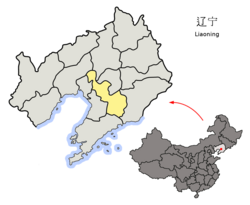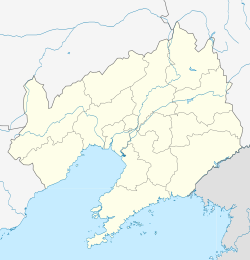Anshan, China
|
Anshan 鞍山市 |
|
|---|---|
| Prefecture-level city | |
 Location of Anshan City jurisdiction in Liaoning |
|
| Location of the city centre in Liaoning | |
| Coordinates: 41°07′N 122°59′E / 41.117°N 122.983°ECoordinates: 41°07′N 122°59′E / 41.117°N 122.983°E | |
| Country | People's Republic of China |
| Province | Liaoning |
| Municipal seat | Tiedong District |
| Districts and Counties | |
| Government | |
| • CPC Anshan | Wang Shiwei Committee Secretary |
| • Mayor | Wu Zhongqiong |
| Area | |
| • Prefecture-level city | 9,252 km2 (3,572 sq mi) |
| • Land | 8,563 km2 (3,306 sq mi) |
| • Water | 689 km2 (266 sq mi) 7.4% |
| • Urban | 624 km2 (241 sq mi) |
| Highest elevation | 1,141 m (3,743 ft) |
| Lowest elevation | 2 m (7 ft) |
| Population (2010 census) | |
| • Prefecture-level city | 3,645,884 |
| • Density | 390/km2 (1,000/sq mi) |
| • Urban | 1,529,850 |
| • Urban density | 2,500/km2 (6,300/sq mi) |
| Time zone | China Standard (UTC+8) |
| Area code(s) | 412 |
| Licence plates | 辽C |
| Administrative division code | 210300 |
| ISO 3166-2 | cn-21-03 |
| Website | http://www.anshan.gov.cn/ |
Anshan (Chinese: 鞍山; pinyin: Ānshān; literally: "saddle mountain") is the third largest prefecture level city in Liaoning province, People's Republic of China. Situated in the central area of the province, Anshan is about 92 kilometres (57 mi) south of Shenyang, the provincial capital. Anshan is on the boundary between the Mountains of eastern Liaoning and the plains of the west. The prefecture has a population of 3,584,000 people and covers an area of about 9,252 km2 (3,572 sq mi). The distance from the east to the west of the prefecture is 133 km (83 mi). The area contains the famous Qianshan National Park. The city's name is derived from the shape of a nearby mountain that resembles the shape of a horse's saddle, which can be seen on the left (west) about five minutes before the northbound train arrives at Anshan Station. Anshan is home to the Anshan Iron and Steel Group, one of the largest steel producers in China. Anshan is sister cities with Sheffield
Anshan has a population of 3.65 million at the 2010 census. Anshan holds one third of the worlds supply of talcum Anshan holds a quarter of the worlds reserves of magnesite Anshan also produced the largest ever jade stone, now a local tourist attraction carved as a Buddha. The built up area encompassing 4 Anshan urban districts (1,529,350 inhabitants) and urban Liaoyang is home to more than 2.17 million inhabitants in 2010.
The area of Anshan has been inhabited since prehistoric times. The area remained of little significance, a small city in Liaodong province, overshadowed by neighbouring Liaoyang city, until the mid 20th Century. In 1587 Anshan was fortified by the Ming Dynasty to combat the growing power of the Manchu. The city was burnt down during the Boxer Rebellion, and was destroyed again in the Russo-Japanese War (1904–1905). As a result of this war, Japan had gained influence in Liaoning and was engaged in industrialising the region. Anshan lay beside the new South Manchuria Railway line that ran from the port of Dalian to the major city of Shenyang. As a joint Sino-Japanese venture, Anshan Zhenzing Iron Ore Company Unlimited was started in Anshan in 1918. After the Mukden Incident in 1931, Japan occupied the northeast of China. The mills were turned into a Japanese owned monopoly. In 1933, the site was expanded to include steel production and the company was renamed Showa Steel Works. Anshan became part of the Japanese puppet state of Manchukuo. Additional industries developed around the iron and steel mills. The city of Anshan grew significantly in size around this new industrial site.
...
Wikipedia

